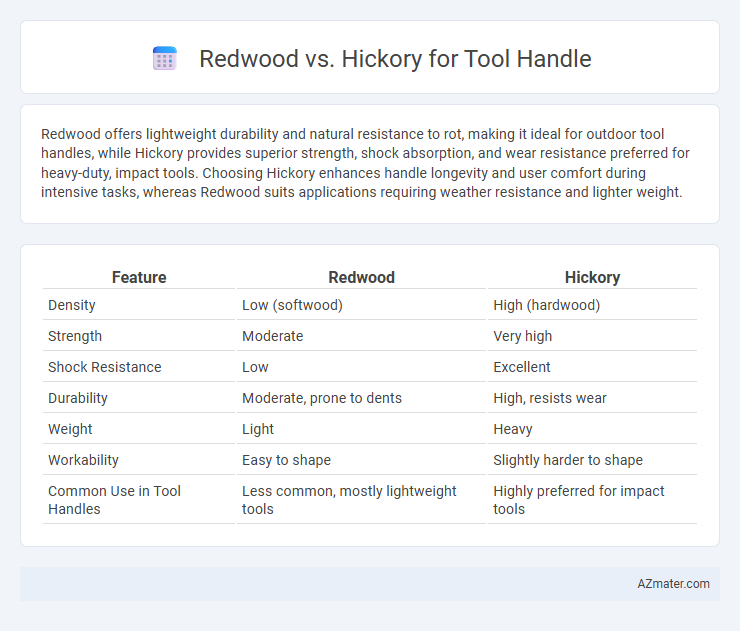Redwood offers lightweight durability and natural resistance to rot, making it ideal for outdoor tool handles, while Hickory provides superior strength, shock absorption, and wear resistance preferred for heavy-duty, impact tools. Choosing Hickory enhances handle longevity and user comfort during intensive tasks, whereas Redwood suits applications requiring weather resistance and lighter weight.
Table of Comparison
| Feature | Redwood | Hickory |
|---|---|---|
| Density | Low (softwood) | High (hardwood) |
| Strength | Moderate | Very high |
| Shock Resistance | Low | Excellent |
| Durability | Moderate, prone to dents | High, resists wear |
| Weight | Light | Heavy |
| Workability | Easy to shape | Slightly harder to shape |
| Common Use in Tool Handles | Less common, mostly lightweight tools | Highly preferred for impact tools |
Introduction to Redwood and Hickory Tool Handles
Redwood tool handles offer lightweight strength and natural resistance to decay, making them ideal for outdoor and moisture-prone environments. Hickory handles are renowned for exceptional shock absorption and durability, favored in heavy-duty applications requiring impact resistance. Both materials provide unique benefits, with redwood excelling in rot resistance and hickory delivering superior toughness for tool longevity.
Wood Properties: Strength and Durability Comparison
Hickory wood is renowned for its exceptional strength and shock resistance, making it the preferred choice for tool handles that require durability under heavy use. Redwood, while lighter and more resistant to moisture and decay, lacks the dense hardness and impact absorption of hickory, limiting its effectiveness for high-stress applications. Therefore, hickory's superior tensile strength and toughness provide longevity and reliability that redwood cannot match in demanding tool handle scenarios.
Weight and Balance: Redwood vs Hickory
Redwood tool handles are lighter than hickory, making them easier to maneuver and less fatiguing for extended use. Hickory, being denser, offers superior balance and durability, providing better shock absorption and control during heavy-duty tasks. Choosing between redwood and hickory depends on the priority of lightweight handling versus long-lasting strength and balance.
Impact Resistance and Shock Absorption
Hickory is known for its superior impact resistance and shock absorption, making it the preferred choice for tool handles subjected to heavy, repetitive strikes. Redwood, while lightweight and durable, lacks the density and fibrous structure that provide the high shock tolerance seen in hickory. For applications demanding exceptional durability and reduced user fatigue, hickory handles offer better performance and longevity.
Workability and Ease of Shaping
Redwood offers superior workability for tool handles due to its lightweight and softer grain, making it easier to shape and carve with hand tools or machinery. Hickory is denser and harder, which provides exceptional durability but requires more effort and skill during shaping, often demanding sharper tools and slower work. Both woods are popular, but redwood's ease of shaping benefits those prioritizing quick, precise handle crafting.
Moisture Resistance and Longevity
Hickory offers superior moisture resistance compared to redwood, making it an ideal choice for tool handles frequently exposed to sweat and outdoor elements. Its dense grain structure ensures exceptional durability and longevity, preventing warping or splitting over time. Redwood, while lightweight and moderately resistant to moisture, lacks the robustness needed for heavy-duty tool handles subjected to regular stress.
Cost and Availability of Redwood and Hickory
Redwood tool handles tend to be less expensive but can be harder to find due to limited commercial availability and sourcing primarily from specific regions. Hickory is widely available and preferred for its superior strength and shock resistance, resulting in a moderate price range reflecting its durability and demand. Overall, hickory handles offer better value for heavy-duty tools despite a slightly higher cost, while redwood is a budget-friendly option for lighter applications.
Comfort and Ergonomics in Practical Use
Redwood offers lightweight properties and a smooth texture, enhancing comfort and reducing user fatigue during prolonged tool use. Hickory provides superior shock absorption and durability, supporting ergonomic grip and impact resistance for heavy-duty tasks. Choosing between them depends on prioritizing either lightweight comfort (Redwood) or robust ergonomic support and vibration dampening (Hickory).
Maintenance and Care Requirements
Redwood tool handles require minimal maintenance due to their natural resistance to decay and moisture, making them ideal for outdoor or damp environments. Hickory handles demand regular care, including oiling and sanding, to prevent drying out and cracking, ensuring durability under heavy use. Proper maintenance extends the lifespan of both, but hickory's higher density and strength make it more sensitive to neglect.
Best Uses: Choosing the Right Wood for Your Tool Handle
Hickory is best suited for tool handles requiring high shock resistance and durability, such as hammers and axes, due to its dense grain and strength. Redwood, while lighter and more resistant to decay, is ideal for tools used in outdoor or damp environments where moisture resistance is crucial. Selecting between hickory and redwood depends on balancing the need for impact strength versus environmental exposure for optimal tool handle performance.

Infographic: Redwood vs Hickory for Tool Handle
 azmater.com
azmater.com